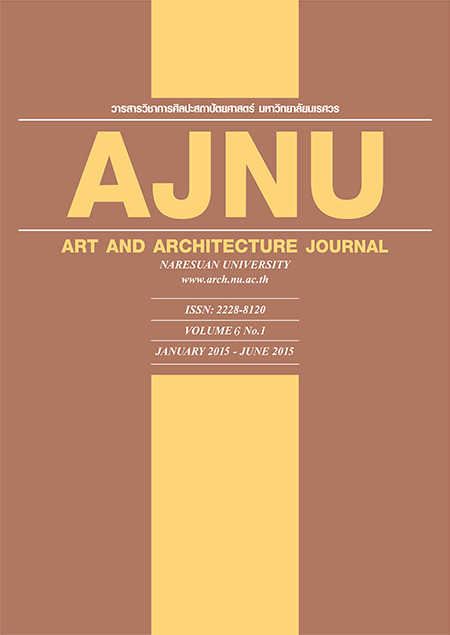สถาปัตยกรรมเรือนพื้นถิ่นกลุ่มชาติพันธุ์ ๙ จังหวัดภาคเหนือตอนล่าง กรณีศึกษา: เรือนลาหู่ เรือนลาวโซ่ง และเรือนไทยสุโขทัย
Main Article Content
Abstract
พื้นที่บริเวณ ๙ จังหวัดภาคเหนือตอนล่าง ได้แก่ จังหวัดกำแพงเพชร ตาก นครสวรรค์ พิจิตร พิษณุโลก เพชรบูรณ์
สุโขทัย อุตรดิตถ์ และอุทัยธานี มีกลุ่มชาติพันธุ์ต่างๆ หลายชาติพันธุ์ ที่ตั้งถิ่นฐานมาแต่ดั้งเดิมหรืออพยพมาจากที่อื่นทั้งในประเทศ
และต่างประเทศ จากผลการศึกษาสถาปัตยกรรมเรือนพื้นถิ่นของ ๓ กลุ่มชาติพันธุ์คือ กลุ่มลาหู่ กลุ่มลาวโซ่ง และกลุ่มไทยสุโขทัย
โดยกำหนดให้เป็นตัวแทนของกลุ่มชนไทยภูเขา กลุ่มไทยลาว และกลุ่มไทยถิ่นตามลำดับ พบว่าปัจจัยที่ส่งผลให้เกิดความ
เปลี่ยนแปลงรูปแบบทางสถาปัตยกรรมเรือนพื้นถิ่น คือ สภาพแวดล้อมชุมชนที่ส่งผลกระทบต่อวิถีชีวิตของกลุ่มชาติพันธุ์ รวมทั้ง
ความต้องการยกฐานะทางสังคม ในขณะเดียวกันผลการวิจัยพบว่าคติความเชื่อของกลุ่มชาติพันธุ์ มีผลอย่างมากต่อการรักษา
รูปแบบทางสถาปัตยกรรมพื้นถิ่นกลุ่มชาติพันธุ์ไว้ แบ่งออกได้ ๒ ประเภท ประเภทแรกชุมชนเป็นผู้สร้างความเชื่อขึ้นมา เพื่อรักษา
ความสงบสุขและดำรงอยู่ซึ่งเผ่าพันธุ์ของตน ผ่านความเชื่อในเรื่องของผีและขวัญ ได้แก่ กลุ่มชาติพันธุ์ลาหู่ และกลุ่มชาติพันธุ์ลาว
โซ่ง โดยรูปแบบเรือนถูกกำหนดตามความเชื่อของผู้นำจิตวิญญาณ ประเภทที่สอง ชุมชนมีความเชื่อและดำรงรักษาประเพณีของ
ศาสนาพุทธ ความเห็นของคนในชุมชนมุ่งไปสู่ความพ้นทุกข์ทางใจ ได้แก่ กลุ่มชาติพันธุ์ไทยสุโขทัย โดยรูปแบบเรือนนั้นสอดคล้อง
ไปตามบริบทของพื้นที่ และมีความอิสระในการจัดพื้นที่ใช้สอยภายในเรือน
The lower northern region of Thailand consists of nine provinces namely; Kamphaeng Phet, Tak,
Nakhonsawan, Pichit, Phitsanulok, Phetchabun, Sukothai, Uttaradit and Uthaithani where there are various
ethnic groups who could be considered original Thai’s with others having migrated from surrounding
countries. The study looked at the architectural styles of vernacular houses of the ethnic groups: Lahu Tribe
representing the hill tribe group, Lao Song Tribe representing the Thai-Lao group, and Thai Sukothai Tribe
representing the Thai Tin group. It was found that a number of factors influence the styles of the architecture
of house construction: namely the environment of the community which affects the ethnic groups’ lifestyles
and the increase of social status, the religious beliefs are also a factor that affects the styles of the
architecture of house construction. The beliefs are divided into two types. The first type is created by the
community aiming to keep the peace and long life of their own ethic group through the belief of ghosts and
morality. This belief is practiced by the Lahu Tribe and the Lao Song Tribe. The style of the architecture for
house construction would be determined by their own spiritual leader. The second type comes from the
community who preserve Buddhism and its traditions with the belief that aims to end suffering (dukkha). This
belief is practiced by Thai Sukothai Tribe. Their styles of the architecture for house construction are in
accordance to work area and the independence in designing space untilisation.


